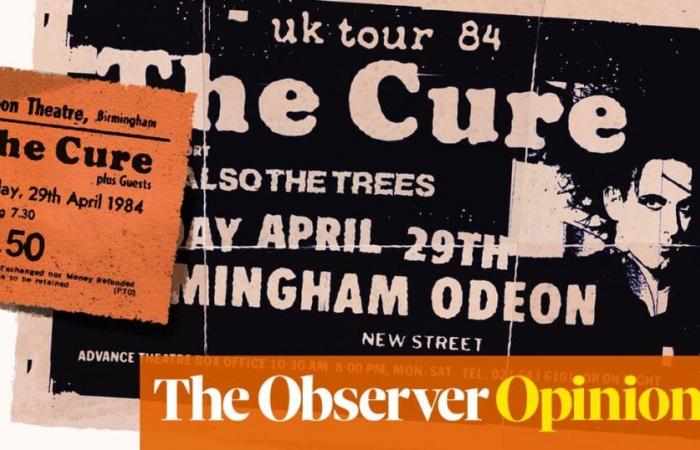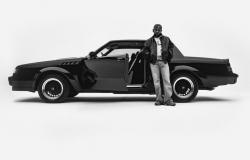The first time I saw the Cure was on 29 April 1984. The Birmingham Odeon show opened with a set from rural Worcestershire’s pre-Raphaelite goths And Also the Trees, whose early albums remain a guilty pleasure, and about whom I once sent a self-aggrandising letter to ZigZag magazine. The Cure’s set drew heavily on the dark post-punk fundamentalism of Seventeen Seconds, Faith and Pornography, but previewed eight songs from the unreleased The Topevidencing a worrying drift towards melody, not what the 15-year-old me wanted at all.
The ticket cost £4.50 and I bought it before Andy Anderson, who was black, was announced as the new drummer. This was lucky, as my family discouraged me seeing bands with black members. I remember making the case for Big Country, despite them having a black bassist, because of their reliance on a bagpipes-styled guitar sound. I think UB40 slipped under the net because even gran loved that Neil Diamond cover. Different times!
The last time I saw the suddenly much bigger Cure was 18 months later, alone, at the National Exhibition Centre, for £5.50. It was an amazing 25-song, career-spanning set. Apparently. I was in the first tier of raised seating and, emboldened by my success on the Army Cadets’ assault course, as the lights dipped when the support act Hard Corps came on, I decided to grasp the barrier at the front with both hands to do a forward roll 20ft or so down into the main stalls below. But I fell on my head owing to not being a member of the SAS, so the rest of the night is a blank. It says on the internet that the Cure encored with Gary Glitter’s Do You Wanna Touch Me?, but I don’t remember. Different times.
After that I parted company with the Cure – I don’t know why – until my kids started listening to them, astonished that I’d seen their early incarnation twice. Having realised what I’d been missing, I dutifully pulled over in a layby by the Rollright Stones in Oxfordshire the Thursday before last to try to secure us tickets to their only show of this year, at London’s Troxy cinema this week. Of course they were all gone in one second. But, because of the ethical bloody-mindedness of frontman Robert Smith, pretty much all of them seem to have sold for the price they were supposed to. Suddenly, the 65-year-old post-punk panda is a beacon of hope against the seemingly insurmountable super-monetisation of every aspect of modern life. Here’s why.
For 14 years, the Tory mindset didn’t see culture as a spiritual or intellectual benefit to the citizen, merely as something that was failing to generate as much money as it could. The culture war they stoked was partly about preventing any of us from experiencing any culture. Affordable tickets weren’t a good thing, enabling ordinary people to benefit from culture, but a terrible failure to maximise income potential. Being allowed to pay £850 to see Oasis in a football stadium is one of the things that tells us that we live in a free society.
I’ve said it before, here, only last month, but in 2015, when the then Tory culture secretary Sajid Javid was asked to address secondary market ticket prices he said that ticket touts were “classic entrepreneurs” and their detractors were the “chattering middle classes and champagne socialists, who have no interest in helping the common working man earn a decent living by acting as a middleman”. But even then the “touts” were bots run by organised criminals, or tacitly legal ticketing loopholes created by the ticket agencies themselves. Concert and theatre-going audiences were not citizens in search of self-improvement or the sublime experience of temporary transcendence, but pigs to be farmed by big business for the monetary value of their pathetic enthusiasms.
Attempting to set ticket prices at the level the artist wanted was regarded by the last government as a socialist intervention in the marketplace, even if the ticket price had already been subsidised by government arts investment. This shouldn’t be a surprise given that their whole ethos was based around selling big business the infrastructure we’d already paid for. But allow a ticket to actually sell for face value and the next thing you know we’ll all be lining up in the town square, waving our hoes, and singing The Red Flag, because we could now see Oasis for the price of a month’s, rather than a year’s, wages.
In opposition, the Tories are furious about Starmer accepting two Taylor Swift tickets. In government, they allowed it to become impossible for most people to attend anything remotely popular unless they had connections or LOADSAMONEY! Viagogo’s subsidiary StubHub, which wouldn’t answer any of my emails, stopped selling my tickets at a 500% mark-up after I spent a day hanging around its Oxford Circus outlet, shouting and eating all the free sweets on the counter while frightening the customers, as the bloke behind the desk recited a prepared script about how what it was doing was legal. Liam Gallagher will pick a fight with a post-box, but not with a ticket agency.
But for next week’s Cure show, everything went through the Dice ticketing app at £45, with no extras, and the one or two touts pushing tickets at £831 on Viagogo are currently being hunted down by Robert Smith’s trained vampire bats. It can be done! And maybe this precedent means when the Cure embark on that final tour, fans will pay what the band wanted them to. Robert Smith is the Mr Bates of ticketing, surely due an OBE and an ITV drama staring a black-wigged Toby Jones in eyeliner as its reluctant hero. Mr Smith Versus Viagogo. I volunteer to play an idiot falling out of a balcony on to his head.






